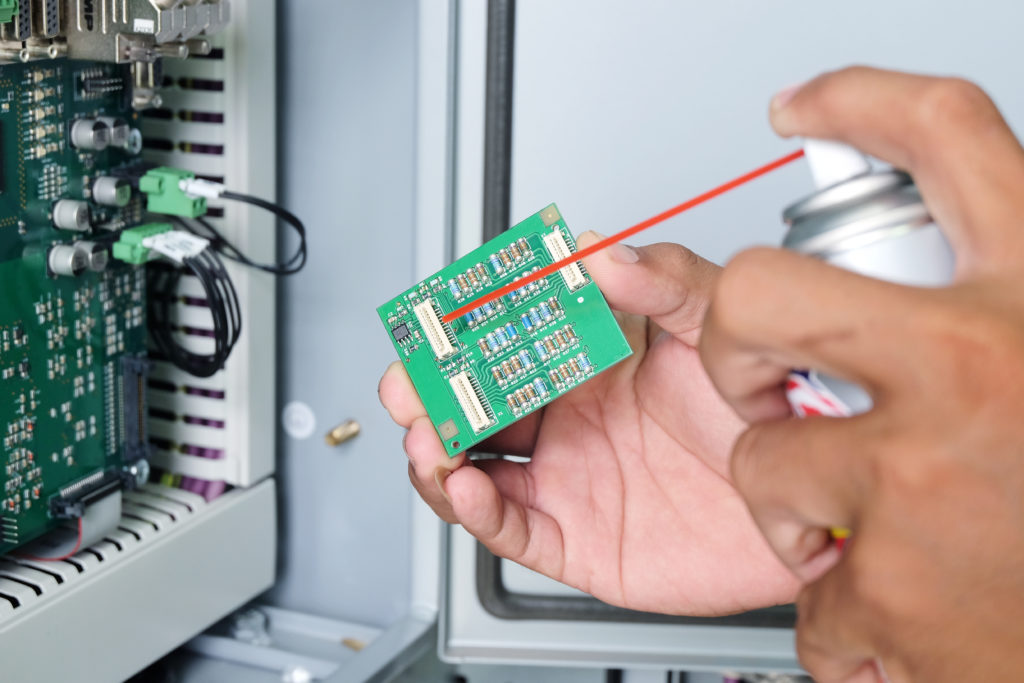Circuit boards can be located in almost every electrical device, including industrial equipment and PCs. With time, dust, water, and grime can find their way into your devices and accumulate to a level where action must be taken for prevention of permanent damage to this equipment. The fans that are regulating the equipment’s temperature that is suitable for efficient functioning can ensnare debris from nearby surfaces or in the air. The accumulation of unwanted material can cause overheating and component malfunction. Liquids such as water contains additives that is not the best thing for electronics. Drinking water from the tap can contain sodium chloride, ions and various other minerals which can heighten the reaction to electronics. It could lead to short-circuiting that can harm the circuit and damage the equipment.
Safety And Prevention Measures For Circuit Boards
Get into the habit of keeping electronics in OFF position when cleaning, since this could lower the effect on electronics is it sustained water damage. Always practice caution when you’re handling circuit boards:
- Make sure the device is disconnected from its power source.
- Do not stand near water.
- Wear clothes that is perfectly dry.
It could be hazardous to disassemble hardware of electronics;therefore, ensure you are familiar with how to handle the devices appropriately when disassembling them and how to reassemble them again back to operational state.
How To Clean Circuit Boards?
For cleaning PC Boards effectively, you must use the right techniques and tools. The easies methods will include:
- Baking soda
- Electrical cleaner
- Compressed air
- Distilled water
- Isopropyl alcohol
- Household cleaners
Always use a lint-free cloth and soft brush to ensure you are not damaging any of the tiny components.
Using Compressed Air
For basic repairs, using compressed air is an unobtrusive method for freeing up and dust lying on the electronics or inside the equipment and blowing it out. Short bursts of air are used for spraying air into ventilation ports. If you’re not happy with the results, open the device, using a screwdriver and carefully work around components, to clean the circuitry.
Using Baking Soda
Sodium bicarbonate or baking soda is an effective method for discarding dirt with minor risk of damaging your board. It contains mild abrasive characteristics that is perfect for removing residue or corrosion that would otherwise not be removed with simpler methods like a brush and distilled water. Baking soda is best for treating corrosion since it dissolves the affected area and neutralizes any acidic qualities in the residue.
Utilizing Isopropyl Alcohol
Isopropyl is an excellent PCB cleaner since it evaporates easily and is affordable. Compared to other cleaners which are used for this purpose, alcohol possesses less chemicals. You must however use isopropyl alcohol on circuit boards which are at ninety person or higher. High-percentage isopropyl alcohol can result in undesirable effects when in contact with your body, therefore, be sure to wear goggles and latex gloves.
Using Distilled Water
Distilled water is better than any other liquids when mixing a cleaning solution since it does not contain ions which is conductive to electronic devices. Pure distilled water won’t degrade your electronic equipment. Take note, it can contaminate quickly from dirt in the air or on your hands, therefore you should seal the remainder of distilled water when not using to prevent contact with your bare hands.
Using Household Cleaner
Phosphate-free household cleaners works well for cleaning PCBs too. It could be efficient for protection against corrosion since it contains helpful cleaning properties.

Leave a Reply